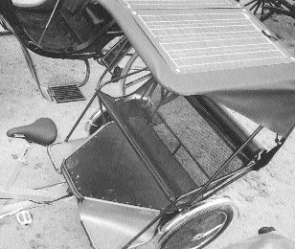 “I was interested to see the solar electric recumbent in A to B 38. It occurred to me that if you could power a recumbent tricycle with two solar panels, one could probably power an electric rickshaw with three or four such panels?”
“I was interested to see the solar electric recumbent in A to B 38. It occurred to me that if you could power a recumbent tricycle with two solar panels, one could probably power an electric rickshaw with three or four such panels?”
Felicity Wright
Redditch
With the oil supply/demand crisis on the way, this may well become a fascinating question. At present, rickshaws are being replaced by internal combustion machines of various kinds, and that will have to change. But is a solar-powered rickshaw viable? We have all the data we need from past A to B magazines – issue 37, on solar power, and issue 39 featuring an electric-assist rickshaw.
As a rule of thumb, the sun supplies around one kilowatt of energy per square metre, which just happens to be the roof area of a typical rickshaw. Unfortunately, another rather more depressing rule of thumb suggests that commercial panel efficiency is somewhere in the region of 10%, reducing peak power to 100 watts. In practice, our Unisolar flexible panels did even worse with British solar radiation, achieving a peak output equivalent to 65 watts per square metre, or 390watt/hours (or Wh) per day.

Cycles Maximus solar- powered pedicab
The roof of the Cycles Maximus rickshaw featured in A to B 39, measures approximately 100cm by 110cm, giving a practical collection area of about 1.1 square metres, or 7.2 times the size of the panels in our previous experiment.Thus, provided our rickshaw was always in the open – something hard to arrange in a cityscape, for example – we could reasonably expect to see peak power of 72 watts, and daily output of 430Wh.
…future developments will depend on the price and availability of oil…
One immediate problem – in UK climes at least – is that our roof-mounted panels were angled towards the south at 20 degrees because at our latitude, a horizontal panel would never be fully effective. Another problem is cloud cover – even in June, the average panel output was cut almost by half, to 36.6watt/hours per day.Taking these factors into account, it’s unlikely that our rickshaw would generate more than 200Wh per day in fine weather, and virtually nothing on an overcast winters day.
The powerful Lynch motor on the Cycles Maximus rickshaw had a battery of 828Wh, giving about two hours power-assistance, well loaded in hilly country. So again, rather depressingly, we are brought to the conclusion that four days, or 40 hours, constant charging in mid-summer would give only two hour’s use…With the less power- hungry Heinzmann motor, the equations become a little more favourable – somewhere in the region of ten hours charging per motor/hour.
Of course, the power consumed depends on the terrain. In a relatively flat city, an hour’s power-assistance per day might well be sufficient, but in this case, we are really looking at a human-powered vehicle with occasional motor assistance, rather than the other way around!
Naturally, once we get close to the equator, we have a great deal more sunlight to play with.With more powerful solar radiation and no cloud cover, we could reasonably expect to generate peak power of up to 100 watts, or perhaps 600Wh per day, giving some three hours motor-assistance.There are other incidental advantages – the solar panels would help to keep the occupants cool by absorbing (and reflecting) solar radiation, and although a battery would be required to deal with the peaks and troughs of production and use, it could be quite small, itself reducing the weight of the machine.
Several experimental solar rickshaws have been trialled in India, one impractical monster weighing 300kg, or nearly three times the weight of the British-designed Maximus! Some have been built with access to prodigious overseas aid, such as the rickshaw claiming to carry panels with an output of 850 watts – clearly either satellite- grade technology, or a surface area of a great deal more than one square metre…There are also a number of ‘exhibition’ solar machines around, but these are a long way from earning a living day-to-day. As with so many other things, future developments will depend on the price and availability of oil. State of the art panels, with an efficiency of 30% or more, would make a lightweight solar vehicle perfectly viable, but only in a sunny area!
![]()
